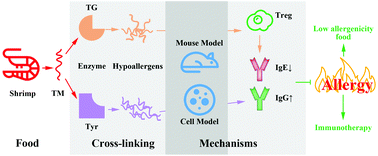Cross-linking of shrimp tropomyosin catalyzed by transglutaminase and tyrosinase produces hypoallergens for potential immunotherapy
Abstract
Tropomyosin (TM) is the major allergen in shellfish, which causes severe food allergy worldwide and shows wide cross-reactivity in different species. Transglutaminase (TG) and tyrosinase (Tyr) are protein modification enzymes that catalyze substrate cross-linking and change protein structures and properties. The aim of this work was to investigate the effect of TG and Tyr on TM. After TG/Tyr treatment, the cross-linking and protein structural change were observed by SDS-PAGE, scanning electron microscopy and circular dichroism. Furthermore, ELISA and mast cell degranulation assay with allergic sera demonstrated the allergenicity reduction after treatment. An in vivo TM-sensitization mouse model showed that both TG and Tyr treatments reduced the IgE-induction capacity of TM but maintained the IgG-induction ability, making the treated TM a potential hypoallergen. Moreover, TG-but-not-Tyr-treated TM promoted regulatory T cell proliferation and thus may facilitate the establishment of oral tolerance. This work provided an effective method to reduce TM allergenicity and produce hypoallergens, which has broad application prospects in low allergenic food production and allergen-specific immunotherapy.



 Please wait while we load your content...
Please wait while we load your content...